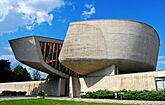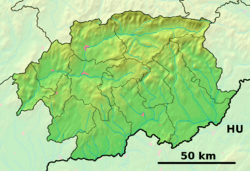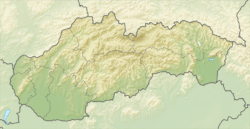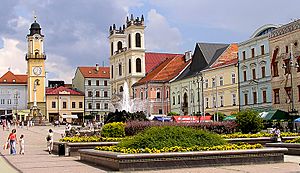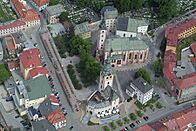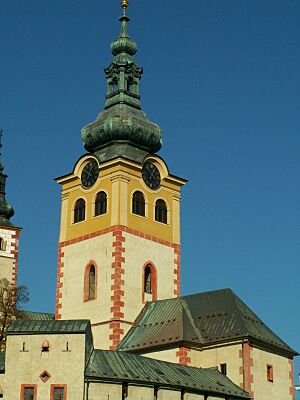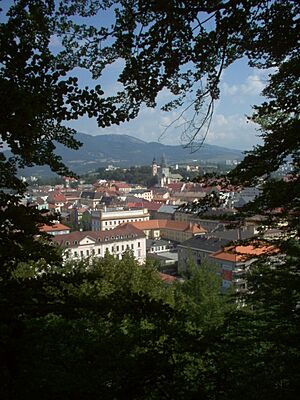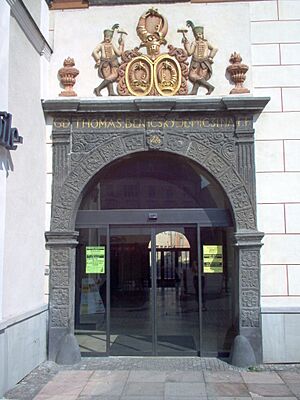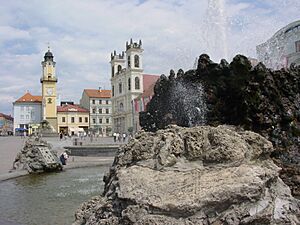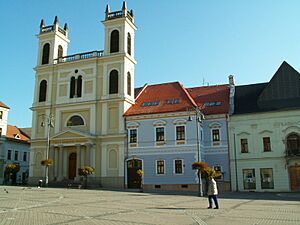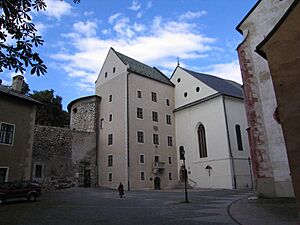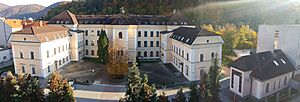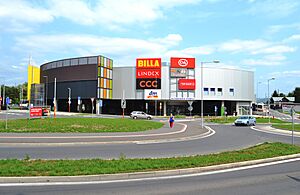Banská Bystrica facts for kids
Quick facts for kids
Banská Bystrica
|
|||
|---|---|---|---|
|
City
|
|||
|
From the top, SNP Square, The Barbakan, Museum of the Slovak National Uprising
|
|||
|
|||
| Etymology: "Mining creek" | |||
| Country | |||
| Region | Banská Bystrica | ||
| District | Banská Bystrica | ||
| First mentioned | 1255 | ||
| Area | |||
| • Total | 103.38 km2 (39.92 sq mi) | ||
| (2022) | |||
| Elevation | 368 m (1,207 ft) | ||
| Population
(2022)
|
|||
| • Total | 74,590 | ||
| • Density | 721.51/km2 (1,868.71/sq mi) | ||
| Time zone | UTC+1 (CET) | ||
| • Summer (DST) | UTC+2 (CEST) | ||
| Postal code |
974 01
|
||
| Area code(s) | +421 48 | ||
| Car plate | BB | ||
| Website | eng.banskabystrica.sk | ||
Banská Bystrica is a lively city in central Slovakia. It sits in a wide valley along the Hron River, surrounded by beautiful mountains like the Low Tatras and Greater Fatra. About 76,000 people live here, making it one of Slovakia's biggest cities.
The city was first settled by German miners in the Middle Ages. It grew because of its rich copper mines. In 1255, it became a special "free royal town" in the Kingdom of Hungary, which gave it important rights. Over time, the city became very pretty with its old churches, grand houses, and strong walls. Today, Banská Bystrica is the capital of its region and district. It's also home to Matej Bel University. Thanks to its history and nearby mountains, it's a popular place for tourists all year round.
Contents
What Does the Name Banská Bystrica Mean?
The name Banská Bystrica has two parts. Banská comes from the Slovak word baňa, which means mine. Bystrica is the name of the local river, and it means swift stream in Slavic languages. So, the city's name basically means "Mining Swift Stream."
The city was first called Villa Nova Bystrice (New Town of Bystrica) in 1255. Later, people started adding the "mining" part to its name. The German name for the city was Neusohl, meaning "New Zvolen," because some early settlers came from the nearby town of Zvolen. In 1920, Banská Bystrica officially became the city's name.
A Quick Look at Banská Bystrica's History
Banská Bystrica's story began with its rich copper mines. People were mining here as far back as 2000–1700 BC! Later, Celts and Germanic tribes lived in the area. The current city was built on an older Slavic settlement.
In 1255, King Béla IV of Hungary gave Banská Bystrica special rights. This helped attract skilled German settlers, and the city grew into an important mining hub. By the 16th century, a company called Ungarischer Handel (Hungarian Trade), owned by the rich Fugger and Thurzo families, became a world leader in copper production. They used advanced mining methods and even offered medical care to their 1,000 workers!
In 1589, the city built strong stone walls to protect itself from the Ottoman Turks, but the Turks never took over the area. Banská Bystrica also became a key center for the Protestant Reformation in the 16th century.
By the 1700s, most of the copper was gone. But new industries like timber, paper, and textiles started to grow. In 1766, Banská Bystrica became the capital of its county and a center for education. The first hospital opened in 1820, a theater in 1841, and a museum in 1889. The railway arrived in 1873, connecting the city to other places.
After World War I, Banská Bystrica became part of Czechoslovakia in 1920.
During World War II, Banská Bystrica played a huge role in the fight against the Nazis. The Slovak National Uprising, one of the biggest anti-Nazi resistance movements in Europe, started here on August 29, 1944. Even though the rebels were defeated and the city was briefly occupied by German forces, it was later freed by Soviet and Romanian troops in March 1945. After the war, Banská Bystrica became a major center for central Slovakia. It has been a university town since the 1950s, with its largest university, Matej Bel University, founded in 1992.
Where is Banská Bystrica?
Banská Bystrica is located about 362 meters (1,188 feet) above sea level. It covers an area of about 103 square kilometers (40 square miles). The city is roughly halfway between Slovakia's two largest cities: Bratislava (the capital) and Košice. The Hron River flows through the city.
The city is surrounded by three mountain ranges: the Low Tatras, the Greater Fatra, and the Kremnica Mountains. These mountains are protected areas because of their natural beauty. Banská Bystrica is also home to the headquarters of the Low Tatras National Park. A smaller mountain called Urpín, about 510 meters (1,673 feet) high, is a popular spot for locals to relax.
Banská Bystrica has four distinct seasons. Summers are warm, and winters are cold and snowy.
Who Lives in Banská Bystrica?
In 2013, Banská Bystrica had about 79,368 people. This made it the 6th largest city in Slovakia. Most people in the city are Slovak (94.7%). Before World War II, there were also many German, Hungarian, and Jewish people living here.
Most people in Banská Bystrica are Roman Catholics (46.6%), while 30.2% do not have a religious affiliation.
What is the Economy Like?
Long ago, Banská Bystrica's wealth came from copper mining. Today, the most important parts of its economy are tourism, timber (wood), and manufacturing. Two of Slovakia's biggest employers, Slovenská pošta (the postal service) and Lesy SR (the national forest service), have their main offices here.
The city wants to grow as a center for tourism, services, and business. It plans to focus on its natural beauty, historical sites, and new technologies.
Fun Places to Visit
Most of Banská Bystrica's historical buildings are around its main square, SNP Square. In summer, the square is full of flowers and outdoor cafes. It's named after the Slovak National Uprising.
- The square has a clock tower built in 1552. It's a bit like the Leaning Tower of Pisa because its top leans about 40 centimeters (16 inches) off center!
- An 18th-century plague column stands in the square. It was built to thank the Virgin Mary for ending a terrible plague.
- The St. Francis Xavier Cathedral is a copy of a famous church in Rome.
- Other cool buildings around the square are old noblemen's mansions and rich citizens' homes, now often turned into shops, restaurants, and cafes. The Thurzo House has a museum with old artifacts and beautiful Gothic paintings.
The museum at the Museum of the Slovak National Uprising has a huge collection of military items. Outside, you can see real World War II tanks, artillery, and even armored trains!
Banská Bystrica is also great for outdoor activities. There are many hiking trails around the city. In winter, you can go cross-country skiing or downhill skiing at nearby resorts like Donovaly, which is also known for dogsled racing.
The Old Town Castle
The oldest part of Banská Bystrica is the town castle, located next to SNP Square. It's protected by what's left of its old walls, including a barbican (a fortified gatehouse), three bastions (parts of the wall that stick out), and sections of the walls. The castle was once the city's administrative center and guarded the king's treasures.
- The Parish Church of the Assumption of the Virgin Mary was built in the 13th century. It has beautiful Gothic altars and sculptures.
- The nearby Church of the Holy Cross was built in 1452.
- The Matthias House was built in 1479. It's a five-story building with a Gothic entrance and balcony. King Matthias Corvinus and his Queen used to stay here.
- The Old Town Hall, built around 1500, is now an art museum.
Culture and Fun
Banská Bystrica has four theaters:
- The State Opera was founded in 1959 and is known for producing talented opera singers.
- Štúdio tanca is a professional contemporary dance theater.
- Bábkové divadlo na Rázcestí is a professional marionette (puppet) theater. It hosts Slovakia's only puppet festival.
- Divadlo z Pasáže is a unique theater where the actors have developmental disabilities. Its goal is to help them be part of society.
The city has several museums:
- The Museum of Central Slovakia, founded in 1889, has exhibits on history and nature.
- The State Gallery at the Old Town Hall shows modern Slovak art.
- The Museum of the Slovak National Uprising has a huge collection of items from World War II, including an outdoor display of tanks and armored trains.
- Other museums include the Literature and Music Museum and Slovakia's only Postal Museum.
Banská Bystrica is also home to several folklore groups that perform traditional Slovak music and dances. The oldest is the Urpín Folklore Ensemble, started in 1957.
For sports fans, FK Dukla Banská Bystrica is the local football (soccer) club, playing in Slovakia's top league. The city also has an ice hockey club, HC 05 Banská Bystrica, and a basketball club, BKP Banská Bystrica.
Learning in Banská Bystrica
Banská Bystrica is a great place for students. It's home to Matej Bel University, which has over 16,000 students. The Academy of Arts teaches performing and fine arts. There's also a branch of the Slovak Medical University here.
The city has many schools, including 15 public primary schools and several high schools. The largest library is the State Scientific Library, with 2 million books. You can also find a branch of the Slovak Academy of Sciences and a small astronomical observatory on Urpín Mountain.
Getting Around Banská Bystrica
Banská Bystrica is well-connected by buses and trains to other parts of Slovakia and Europe. The R1 expressway links the city to Bratislava, the capital.
The Banská Bystrica railway station is an important train hub. Public transport within the city includes trolleybuses and buses. Many people also use their own cars to get to work.
Sister Cities
Banská Bystrica is "twinned" with many cities around the world. This means they have special friendly relationships and often share culture and ideas.
- Alba, Italy
- Ascoli Piceno, Italy
- Budva, Montenegro
- Charleston, United States
- Dabas, Hungary
- Durham, England, United Kingdom
- Halberstadt, Germany
- Herzliya, Israel
- Hradec Králové, Czech Republic
- Kovačica, Serbia
- Larissa, Greece
- Mangalia, Romania
- Montana, Bulgaria
- Radom, Poland
- Salgótarján, Hungary
- Tarnobrzeg, Poland
- Tula, Russia
- Vršac, Serbia
- Zadar, Croatia
Other Forms of Cooperation
Images for kids
See also
 In Spanish: Banská Bystrica para niños
In Spanish: Banská Bystrica para niños




